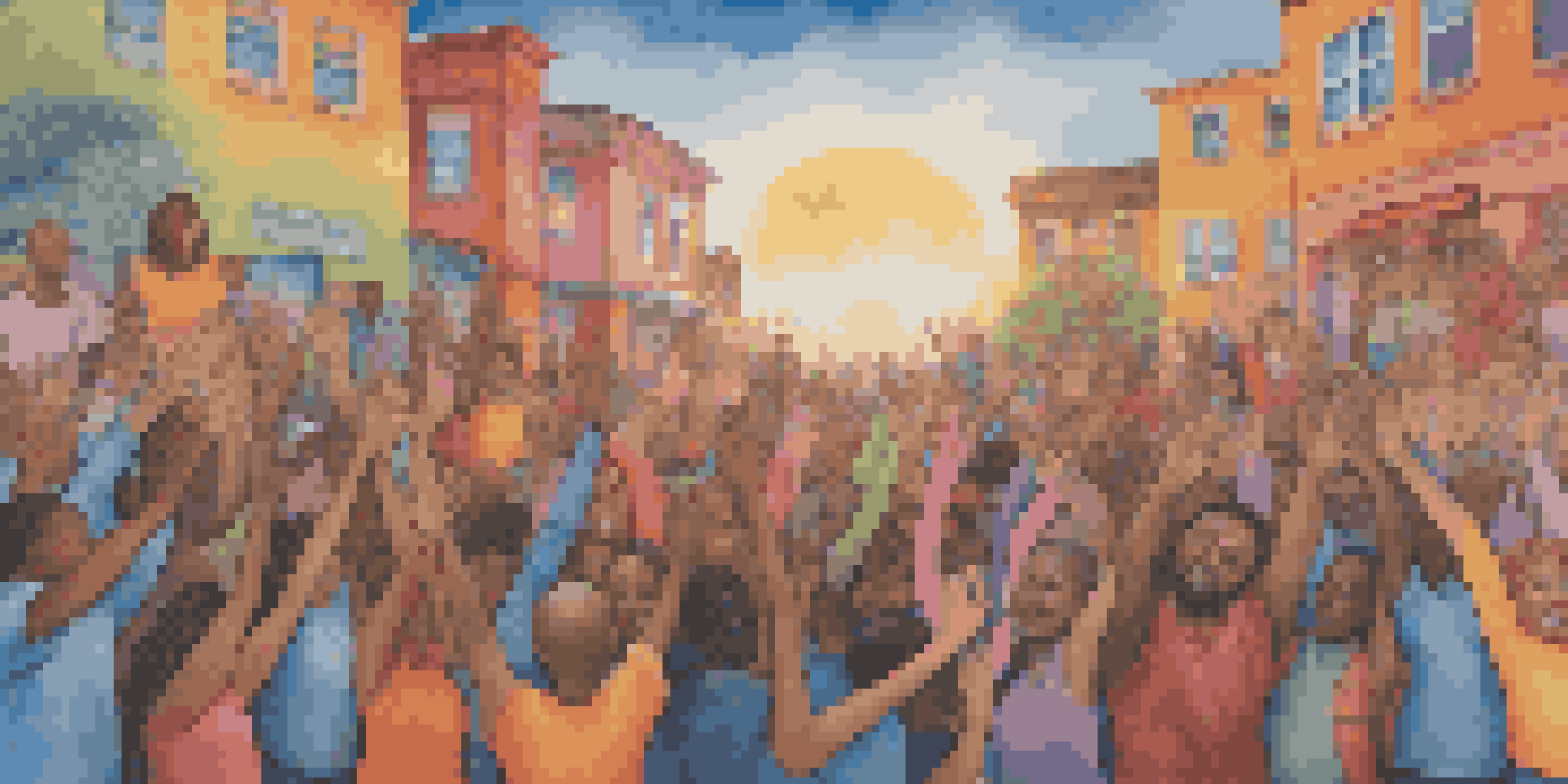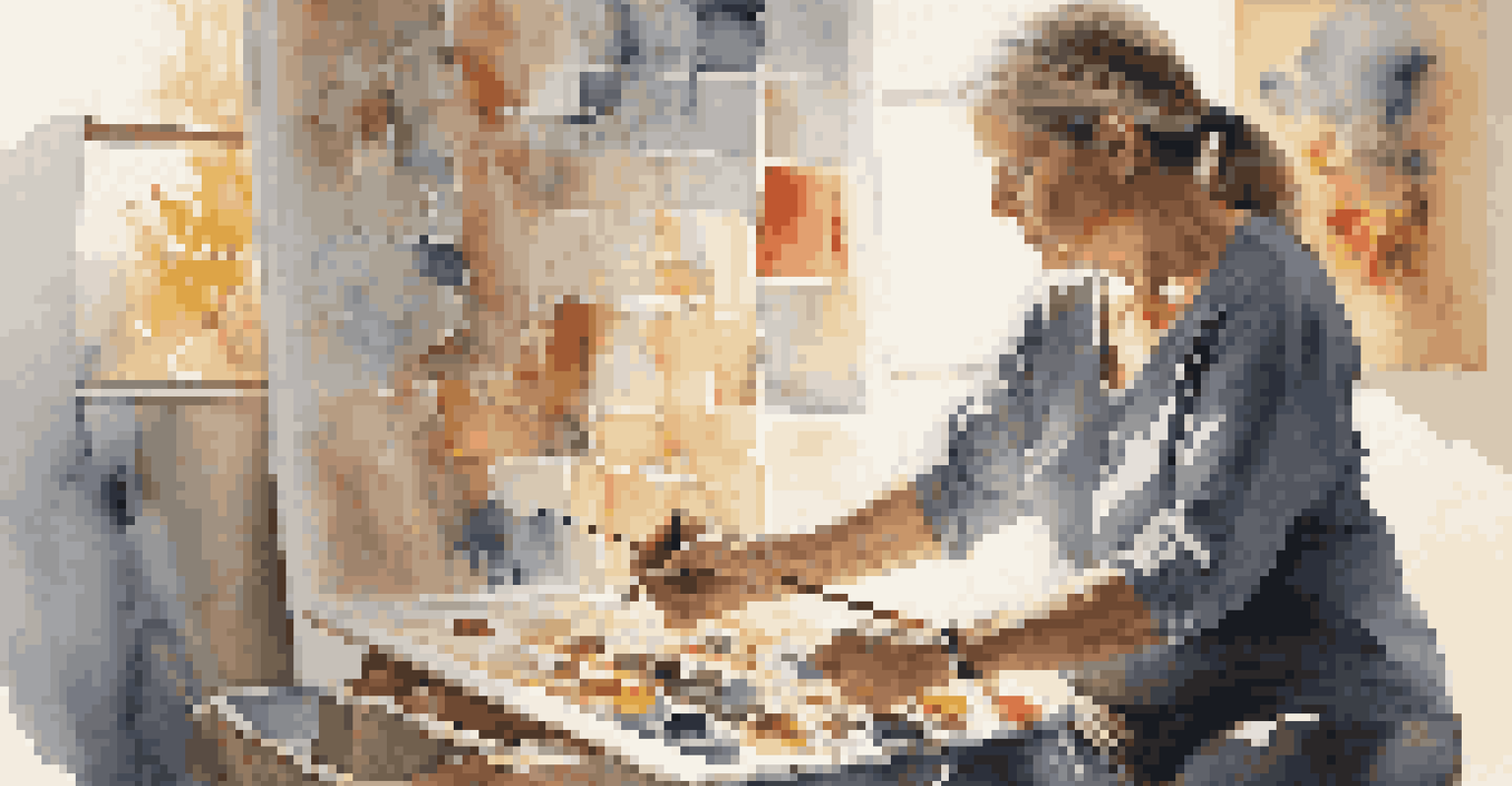Art in Times of Crisis: Emotional Expression During Turmoil

The Role of Art in Reflecting Societal Challenges
Art has always been a mirror to society, particularly during turbulent times. When crises strike, whether it's war, economic downturns, or pandemics, artists often channel their emotions and observations into their work. This expression not only captures the essence of the moment but also serves as a historical record for future generations.
Art is not freedom from discipline, but disciplined freedom.
For instance, during World War II, artists like Pablo Picasso used their canvas to depict the horrors of war, as seen in his iconic painting 'Guernica'. Such pieces evoke strong feelings and provoke thought, allowing viewers to connect with the pain and struggles of others. This connection can be healing, both for the artist and the audience.
Furthermore, art can foster a sense of community in times of upheaval. By sharing their experiences through creative expression, artists can unite people, encouraging dialogue and empathy. This shared understanding can be a powerful antidote to isolation and fear.
Art as a Coping Mechanism During Difficult Times
In challenging circumstances, creating or experiencing art can serve as a vital coping mechanism. Engaging in artistic activities allows individuals to process their emotions in a constructive way. Painting, writing, or playing music can provide an outlet for feelings that might otherwise feel overwhelming.

Consider the impact of art therapy, which has been used for decades to help individuals deal with trauma and stress. For example, during the COVID-19 pandemic, many turned to creative pursuits as a way to manage anxiety and uncertainty. This not only provided distraction but also a means to express feelings that were hard to articulate.
Art Reflects Society's Challenges
Art serves as a powerful mirror, capturing the essence of societal struggles and fostering empathy during turbulent times.
Moreover, art can serve as a reminder of resilience. When people create in the midst of crisis, they often find strength in their vulnerability. Their work becomes a testament to human endurance and the ability to find beauty, even when surrounded by chaos.
Historical Examples of Art in Crisis
Throughout history, there have been countless examples of art emerging from times of crisis. The Great Depression, for instance, inspired a wave of artists to document the struggles of everyday people. Works such as Dorothea Lange's photography captured the hardships faced by many, immortalizing their stories and fostering a sense of empathy.
The artist is not a special kind of person; rather, each person is a special kind of artist.
Similarly, during the AIDS crisis of the 1980s, artists like Keith Haring used their art to raise awareness and advocate for change. His vibrant murals not only expressed the pain of loss but also celebrated life, encouraging communities to come together in support of one another. This illustrates how art can be a powerful tool for activism.
These examples show that art not only reflects the struggles of the times but also serves as a catalyst for change. By giving voice to the marginalized, artists can inspire movements and challenge societal norms, demonstrating the profound impact of creative expression.
Modern Technology and Art in Crisis
In today's digital age, technology plays a pivotal role in how art is created and shared during crises. Social media platforms have become vital spaces for artists to showcase their work and connect with a global audience. This connectivity allows for a rapid dissemination of ideas, fostering a sense of solidarity among those experiencing similar challenges.
During the pandemic, many artists turned to online platforms to host virtual exhibitions and performances. This not only provided an opportunity for creatives to continue their practice but also allowed audiences to engage with art from the safety of their homes. The accessibility of digital art has transformed the way we experience creativity during tough times.
Art as Coping and Healing Tool
Creating and experiencing art allows individuals to process emotions and find resilience amidst crises.
Additionally, technology has enabled innovative forms of artistic expression, such as digital art and virtual reality experiences. These new mediums allow artists to explore and convey complex emotions in ways that traditional forms may not. As we navigate future crises, the fusion of technology and art will likely continue to evolve, offering new avenues for emotional expression.
The Healing Power of Art Communities
Art communities often emerge as a refuge during times of crisis, providing support and encouragement for artists and audiences alike. These communities foster collaboration, allowing individuals to share their experiences and create together. This sense of belonging can be incredibly therapeutic, especially when faced with uncertainty.
For instance, during the Black Lives Matter movement, artists came together to create murals and public installations that voiced collective pain and hope. These collaborative projects not only amplified individual stories but also strengthened community bonds, showcasing the power of art to unite.
Moreover, engaging with art communities can lead to personal growth and healing. Participants often find solace in shared creativity, discovering that their struggles are not faced in isolation. This collective approach to art-making can transform pain into purpose, ultimately fostering resilience in the face of adversity.
Art as a Form of Protest and Activism
Throughout history, art has been a powerful form of protest and activism, especially during crises. Artists often use their creative platforms to challenge injustices and inspire change. This can take many forms, from provocative street art to poignant performances that speak to societal issues.
For example, during the civil rights movement, artists like Nina Simone used music to address the struggles faced by African Americans. Her song 'Mississippi Goddam' became an anthem of resistance, capturing the anger and frustration of a generation. Such works not only raise awareness but also galvanize people to take action.
Art Fuels Activism and Change
Throughout history, art has been a vital tool for protest, inspiring societal change and addressing injustices.
Art as activism reminds us that creativity can be a form of resistance. By harnessing the emotional power of art, individuals can confront oppressive systems and inspire hope in the face of adversity. This dynamic relationship between art and activism continues to play a crucial role in shaping societal change.
The Future of Art in Crisis: A Lasting Legacy
As we look to the future, the legacy of art created during times of crisis will continue to resonate. The emotional expressions captured in these works not only reflect the realities of their time but also serve as important lessons for future generations. They remind us of our shared humanity and the resilience of the human spirit.
Incorporating new technologies and mediums, artists will likely find innovative ways to express their experiences during crisis. The ability to adapt and respond to changing circumstances ensures that art will remain a relevant outlet for emotional expression and healing.

Ultimately, the future of art in times of crisis will be shaped by our collective experiences and the lessons we learn. By embracing the power of creativity, we can continue to find hope and beauty, even in the darkest of times.